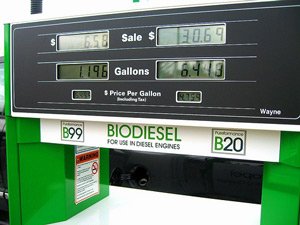What do
B-100, B20, and B5 stand for?
Search this site!
Neat biodiesel is also known as B-100. The number following the 'B' stands for the percentage of biodiesel in the fuel. Biodiesel can be mixed into petroleum diesel fuel at any percentage without problems. One reason this is done is because biodiesel has a higher gel point. When it is mixed with petroleum diesel the gel point is lowered.
 Popular Blends: Popular Blends: • B5 is a common biodiesel blend that is approved by virtually all of the engine manufacturers.
B5 means the fuel is 5% biodiesel and 95% petroleum diesel.
Photo by Skidrd
(License: Creative Commons Attribution 2.0 Generic) • B20 (20% biodiesel, 80% petroleum diesel) is becoming very popular as vehicle engine manufactures approve the use of this blend. B20 should work well in any diesel engine. You probably won’t notice a difference in vehicle performance, or have maintenance issues when using blends of B20 or less. • You probably won't find B100 in America - you'll probably come across B99 instead. This is because there are tax credits offered to producers of biodiesel blends, but not for B100.
Click here or more on maintenance issues (relevant for blends between B20 and B-100).
Here is a list of engine and vehicle manufacturers’ support of biodiesel blends.
(Opens in a new window)
Blending: There are a few different methods of blending biodiesel with petroleum diesel fuel. • It can be blended in tanks prior to arriving at a fuel station. • It can be ‘splash mixed’ - each fuel is added one after the other directly into the fuel tank. • It can be ‘in-line mixed’ - the fuels are added simultaneously into the fuel tank.
Return from 'B-100' to 'Biodiesel FAQ'
Biodiesel Homepage
|